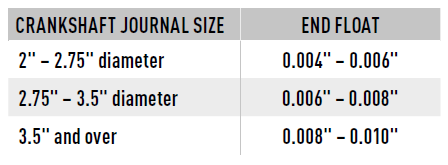Bottom End

The Importance of Bearing Clearances in Rebuilt EnginesRebuilding engines should always take place in a sanitary environment to avoid “building-in” dirt. With processes like engine block re-bore and crankshaft re-grind, the job itself produces dirt and debris which will cause problems when carried around by the oil. Hence, all components (especially engine block oil galleries, oil ways and crankshaft) need to be clean before assembly. OILED UP Bearing surfaces and journals must be thoroughly lubricated during assembly. Oil should run all over bearings, blocks and caps until every surface is fully covered. It should never be spread with a finger or a rag. Once complete, check the lubrication system is working and replacement components match the manufacturer’s specification. BEARING CLEAR Sufficient bearing clearance means good conformability between the bearing and the crankshaft journal. Too little clearance will cause the oil to be squeezed out between crankshaft and bearing, leading to friction and wear. Friction causes the shaft to ride up the bearing as the shaft’s rotation drags oil into the wedge formed between the two surfaces. Oil is forced towards the thin edge of this wedge and the pressure pushes the shaft away from the bearing surface. As the speed of the shaft increases, the oil pressure rises until it is high enough to support the load on the shaft, when it begins to force the shaft towards the centre. DO IT RIGHT The oil pressure in the shaft can be up to several thousand pounds per square inch (psi), compared to a pressure of just 60psi from the oil pump. Therefore, bearing clearance must be to the manufacturer’s specification or the pump can’t circulate the oil to the bearing surfaces. If the journal diameter has worn to below the minimum size stated in the Glyco catalogue, the crankshaft must be reground to the next undersize. Cleanliness is paramount. Dirt trapped behind the steel back of the bearing shell will reduce clearance. Cap bolts should be tightened in accordance with recommended torque figures. If manufacturer’s specifications are unavailable, a general guide is: Crankshaft Journal Clearances • Minimum oil clearance = 0.0005" (1/2 thou") per inch of journal diameter • Maximum oil clearance = the minimum oil clearance calculated as above, plus 0.002" C
For engines with speeds in excess of 6,000 revs/min, always refer to the manufacturer for details of crankshaft journal and crankshaft end float oil clearances.
|
Related Articles Related Downloads |
